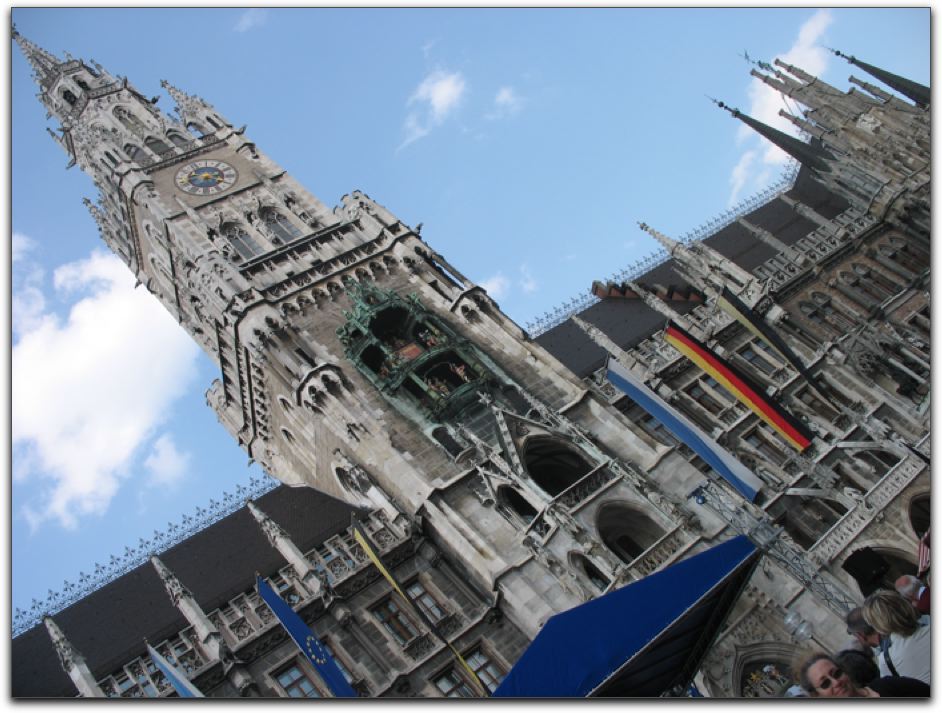
We had, we confess, little interest in the contemporary Munich.
Since Mark's father had been stationed there for some time after the war ended, we hoped to find the intersection where he had a photo of himself taken.
We did have a note to track down The White Rose.
We were also interested in seeing Dachau.
Mark's father had also been to Dachau, shortly after liberation. He took many photographs there that form some of Mark's visual memory of the Sho'a. Mark wanted to check his memory of the photographs with the reality of the actual camp.
Before leaving Karlovy Vary we checked the WUPJ Web site to see if there was a liberal congregation in Munich. And, indeed there was. We wrote to them, alerting them of our imminent arrival, hoping to spend Shabbat with a Jewish community. However, an error in the WUPJ site and our rush prevented us from finding a street address for Beth Shalom. In any case, we never received a response to our email.
The Munich campsite, run by the city, across the Isar River from the zoo, provided a lovely setting for our Shabbat dinner with tea candles, Czech wine and whole wheat seeded braided rolls. The following morning, we took a long walk into the city along the river. In addition to the many bikers and walkers on the path, we were surprised to see surfers ... river surfing! The surfers use small boards and wear wet suits to navigate a very narrow but touchy current on a channel of the Isar.

The flow is from right to left in the photo.
Our walk took us to the Rathaus, with another glockenshpiel, (where we took our official "portrait of the day"), near the open market with many treats including white asparagus and a variety of good olives and pickled tomatoes.

We saw a higher percentage of people in Munich wearing the old-style German (Bavarian?) costume than anywhere else.

Take a look at the lederhosen on the bottom shelf towards the lower left corner of the photo. Mark had gone into the store to look for the address of what seemed to be an interesting museum, and found a variety of camouflage and military wear for sale there. All this added to the eeriness of being in Munich and sapped a desire to get to know the city better. Mark had not felt quite so odd since Villach.
Our walk into town was about three miles, then around town a bit, asking about cafes with wireless so we could sit and relax as well as update the site. We finally found an American type coffee and bagel shop near where we turned from the river into the city and sat till shortly before dark. Then as we walked back "home" along the river we saw what must have been more than a hundred camp fires on both banks dotting the route back, all very beautiful and pretty peaceful. Unfortunately, difficult to photograph.
That made for a total walk of at least 6 miles on our last unscheduled Shabbat until August.
Sunday morning we started out for Freising.
Then to Dachau.
It does not surprise me that the people of Dachau would want to have a separate Wikipedia article for their town, distinct from the concentration camp that bears the same name. Yet, the two are so close, and the camp is at the base of the hill on which the old town stands, that it is hard to accept that the residents of the 1930s-1940s did not know what was happening in their back yard.
At the camp, we we able to attach ourselves to a tour given by (Macintosh user) Phil Bradley. He gave a very good, thorough, intensely expressed tour.
"Dachau" seems synonymous with "concentration camp" the way the "Auschwitz" is synonymous with "death camp".
It is a place of intense evil, calculated sadism.
I [M] once again experienced that cold, choking that swelled through me at Auschwitz and at Terezin. You might think that I might become inured to it; emotionally calloused.
Can that happen?
Towards the end of the tour we saw a short film that included footage of the survivors.
Debbie mentioned afterwards that she needed to close her eyes, hard to see the brutality.
I have always felt the need to keep my eyes wide open.
If this is what was done to people in full view of the perpetrators and seen by those first witnesses who captured the scene on celluloid, I owe it to those, whose images were captured... to look them in the eye and recognize the humanity that others attempted to deny them.
It seems that Mark is not the only son of an American serviceman who is interested in the wartime experiences of his father. On the Web you can find a site devoted to The Third Reich in Ruins by Geoff Walden which:
"presents photos of historical sites associated with Germany’s Third Reich (1933-1945), both as they appeared while in use, and as the remains appear today. These photos give a "then and now" perspective, in many cases, a virtual tour of the sites. I was inspired to write this page by a collection of photos taken by my father, U.S. Army Air Forces Lt. Delbert R. Walden, when he was stationed in Germany in 1945-46."
Given some time, Mark hopes to review his father's old photos and recollections (perhaps, even, the YIVO essay), to make that experience available to a wider public.